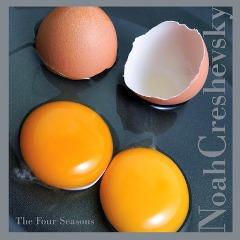Noah Creshevky - The Four Seasons (2013)
Noah Creshevky - The Four Seasons (2013)

1. The Four Seasons: I Summer (12:05) 2. The Four Seasons: II Interlude 1 ( 1:17) 3. The Four Seasons: III Autumn ( 8:54) 4. The Four Seasons: IV Interlude 2 ( 3:00) 5. The Four Seasons: V Winter (11:25) 6. The Four Seasons: VI Interlude 3 ( 0:38) 7. The Four Seasons: VII Spring ( 9:36) Tomomi Adachi - Vocals Teodross Avery - Sax (Tenor) Adrian Banner - Piano Orin Buck - Bass Monique Buzzarté - Trombone Jeremiah Cawley - Vocals Amy Denio - Vocals Sherman Friedland - Clarinet Beth Griffith - Vocals Rich Gross - Banjo Kathy Hanson - Vocals Gary Heidt - Guitar, Vocals Ben Holmes - Trumpet Rodney Jones - Guitar Mari Kimura - Violin Alex Kontorovich - Clarinet, Sax (Alto) Chris Mann - Vocals Maria Mannisto - Vocals Ray Marchica - Drums Al Margolis - Clarinet Gregg Mervine - Drums Marco Oppedisano - Guitar Lonnie Plaxico - Bass Heather Chriscaden Versace - Bass Susan Watts - Trumpet, Vocals Audrey Betsy Welber - Sax (Alto), Sax (Tenor) Amy Zakar - Violin
Composer Noah Creshevsky has worked in electronic music—mostly through constructions made of sampled sounds—for over forty years. This new release in the Tzadik label’s Composer Series is intended as a retrospective of his work of the past twenty years. Perhaps this awareness of the passage of time accounts for the release’s structure: It’s laid out as a single work of four parts dedicated one each to a season, alternating with three brief interludes.
Although electronically composed, the work is rooted in the analog world. Creshevsky takes samples of vocal and acoustic instrumental performances and edits them to create sounds that couldn’t be produced under ordinary circumstances. The overall effect is to create virtual ensembles capable of producing exaggerated or “hyperreal” performances that go beyond the limitations of real instruments and performers—while still conserving the warmth and presence of human performance. The virtual ensemble used here is notably large—there are twenty-seven instrumentalists and vocalists credited.
The music consists of very rapid collages based on deconstructed phrases. Creshevsky takes sampled phrases and dismantles them into fragments, and then builds them back up again fragment by fragment, often with each note or cluster of notes carried by a different sampled sound source. Sometimes a phrase will be broken in half and alternated between sources—as when in Summer, for example, strings and voices complete each other’s phrases. Specific historical styles of music may appear—there’s flamenco guitar in Autumn, and hints of minor key Baroque cadences on the strings in the first Interlude. More often, though, the style is sui generis and is apt to leave the listener with a deeper appreciation of the joints and discontinuities that run not only through this music, but through much else besides. --- avantmusicnews.com
download: uploaded anonfiles yandex 4shared solidfiles mediafire mega filecloudio
Last Updated (Thursday, 07 November 2013 17:07)








